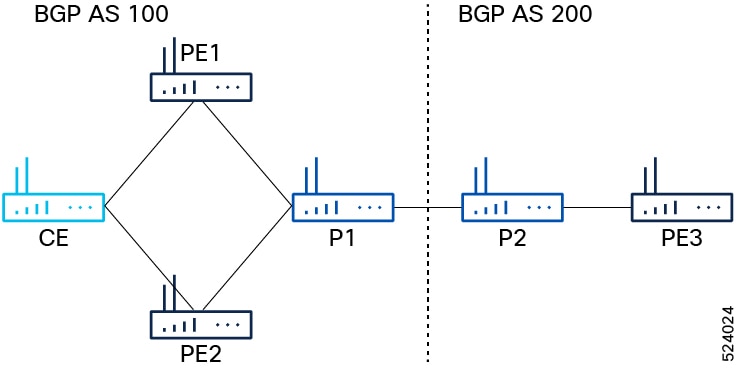EVPN Overview
Ethernet VPN (EVPN) is a next generation solution that provide Ethernet multipoint services over MPLS networks. EVPN operates in contrast to the existing Virtual Private LAN Service (VPLS) by enabling control-plane based MAC learning in the core. In EVPN, PE's participating in the EVPN instances learn customer MAC routes in Control-Plane using MP-BGP protocol. Control-plane MAC learning brings a number of benefits that allow EVPN to address the VPLS shortcomings, including support for multi-homing with per-flow load balancing.
The EVPN control-plane MAC learning has the following benefits:
-
Eliminate flood and learn mechanism
-
Fast-reroute, resiliency, and faster reconvergence when link to dual-homed server fails
-
Enables load balancing of traffic to and from CEs that are multihomed to multiple PEs
The following EVPN modes are supported:
-
Single homing - This enables you connect a customer edge (CE) device to one provider edge (PE) device.
-
Multihoming - This enables you to connect a customer edge (CE) device to two or more provider edge (PE) devices to provide redundant connectivity. The redundant PE device ensures that there is no traffic disruption when there is a network failure. Following are the types of multihoming:
-
Single-Active - In single-active mode, only a single PE among a group of PEs attached to the particular Ethernet-Segment is allowed to forward traffic to and from that Ethernet Segment.
-
Active-Active - In active-active mode, all the PEs attached to the particular Ethernet-Segment is allowed to forward traffic to and from that Ethernet Segment.
-
EVPN Concepts
To implement EVPN features, you need to understand the following concepts:
-
Ethernet Segment (ES): An Ethernet segment is a set of Ethernet links that connects a multihomed device. If a multi-homed device or network is connected to two or more PEs through a set of Ethernet links, then that set of links is referred to as an Ethernet segment. The Ethernet segment route is also referred to as Route Type 4. This route is used for designated forwarder (DF) election for BUM traffic.
-
Ethernet Segment Identifier (ESI): Ethernet segments are assigned a unique non-zero identifier, which is called an Ethernet Segment Identifier (ESI). ESI represents each Ethernet segment uniquely across the network.
-
EVI: The EVPN instance (EVI) is represented by the virtual network identifier (VNI). An EVI represents a VPN on a PE router. It serves the same role of an IP VPN Routing and Forwarding (VRF), and EVIs are assigned import/export Route Targets (RTs). Depending on the service multiplexing behaviors at the User to Network Interface (UNI), all traffic on a port (all-to-one bundling), or traffic on a VLAN (one-to-one mapping), or traffic on a list/range of VLANs (selective bundling) can be mapped to a Bridge Domain (BD). This BD is then associated to an EVI for forwarding towards the MPLS core.
The EVPN EVI range is from 1 to 65534.
-
EAD/ES: Ethernet Auto Discovery Route per ES is also referred to as Route Type 1. This route is used to converge the traffic faster during access failure scenarios. This route has Ethernet Tag of 0xFFFFFFFF.
-
EAD/EVI: Ethernet Auto Discovery Route per EVI is also referred to as Route Type 1. This route is used for aliasing and load balancing when the traffic only hashes to one of the switches. This route cannot have Ethernet tag value of 0xFFFFFFFF to differentiate it from the EAD/ES route.
-
Aliasing: It is used for load balancing the traffic to all the connected switches for a given Ethernet segment using the Route Type 1 EAD/EVI route. This is done irrespective of the switch where the hosts are actually learned.
-
Mass Withdrawal: It is used for fast convergence during the access failure scenarios using the Route Type 1 EAD/ES route.
-
DF Election: It is used to prevent forwarding of the loops. Only a single router is allowed to decapsulate and forward the traffic for a given Ethernet Segment.
EVPN Timers
The following table shows various EVPN timers:
|
Timer |
Range |
Default Value |
Trigger |
Applicability |
Action |
Sequence |
||
|---|---|---|---|---|---|---|---|---|
|
startup-cost-in |
30-86400s |
disabled |
node recovered* |
Single-Homed, All-Active, Single-Active |
Postpone EVPN startup procedure and Hold AC link(s) down to prevent CE to PE forwarding. Startup-cost-in timer allows PE to set core protocols first. |
1 |
||
|
recovery |
20-3600s
|
30s |
node recovered, interface recovered ** |
Single-Homed***, Single-Active |
Postpone EVPN Startup procedure. Recovery timer allows PE to set access protocols (STP) before reachability towards EVPN core is advertised. |
2 |
||
|
peering |
0-3600s |
3s |
node recovered, interface recovered |
All-Active, Single-Active |
Starts after sending EVPN RT4 to postpone rest of EVPN startup procedure. Peering timer allows remote PE (multihoming AC with same ESI) to process RT4 before DF election will happen. |
3 |
 Note |
|
* indicates all required software components are loaded.
** indicates link status is up.
*** you can change the recovery timer on Single-Homed AC if you do not expect any STP protocol convergence on connected CE.

































 Feedback
Feedback